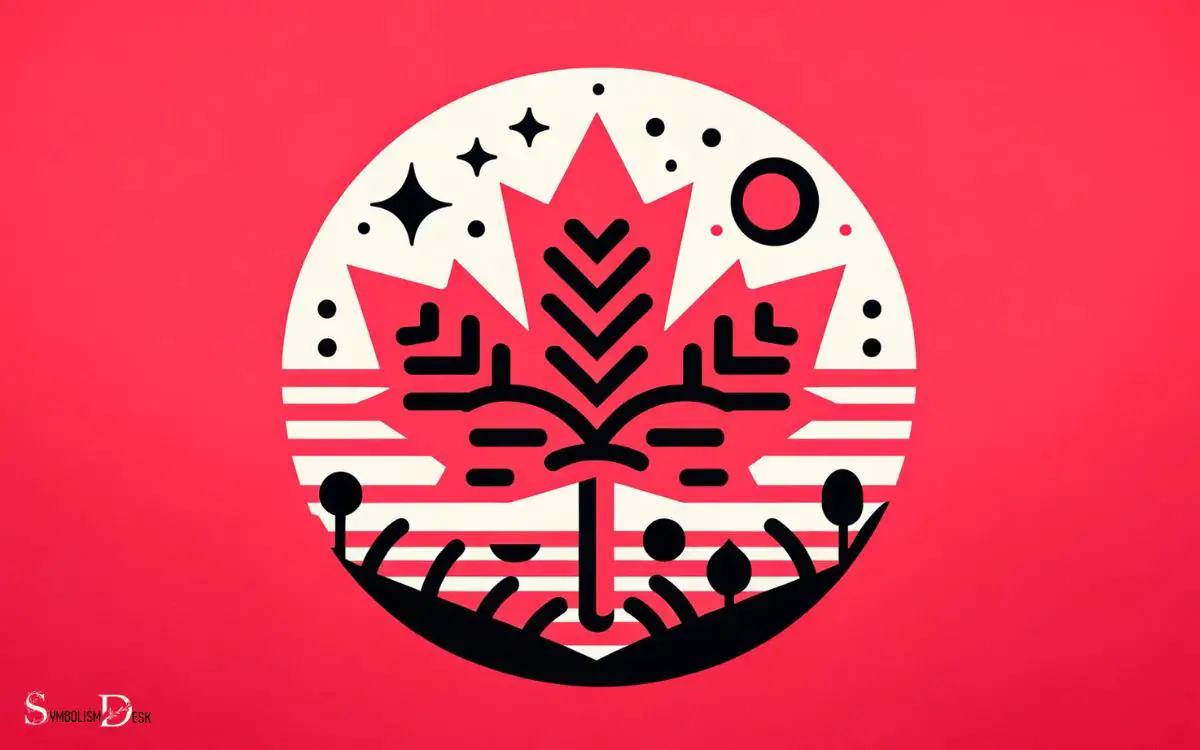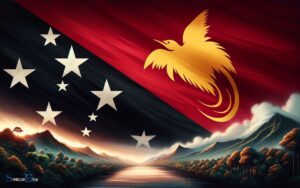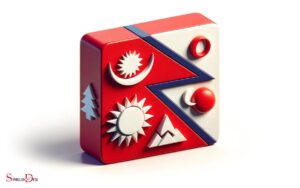What Do the Symbols on the Canadian Flag Mean? Maple Leaf!
The symbols on the Canadian flag, also known as the Maple Leaf, consist of a red field with a white square in its centre featuring a stylized, 11-pointed red maple leaf.
The red symbolizes the Canadian sacrifice during World War I, and the white represents peace and honesty.
The Maple Leaf is a prominent Canadian symbol known for its robustness and its ability to thrive under harsh conditions, representing the resilience, strength, and freedom of Canadians.
The Canadian flag, officially known as the National Flag of Canada, features two vertical red fields on each end and a white square in the middle, making up for the country’s history, geographical location, and the nature of its people.
The Maple Leaf that sits in the centre of the flag is a symbol that has been associated with Canada even before the official adoption of the flag in 1965.
Key Takeaway

4 Symbols and Meanings of the Canadian Flag
| Symbol | Meaning |
|---|---|
| Maple Leaf | The maple leaf is a symbol of Canada and represents the cultural heritage of the nation and the natural resources of Canada. |
| Red Color | The red color on the Canadian flag represents England and symbolizes hope, prosperity, and natural resources. |
| White Color | The white color on the Canadian flag represents peace and tranquility. |
| Two Vertical Red Bands | The two vertical red bands on either side of the flag symbolize the Atlantic and Pacific Oceans which border Canada. |
History of the Canadian Flag
The history of the Canadian flag is a compelling narrative that traces the evolution of a national symbol. Prior to the adoption of the current maple leaf flag in 1965, Canada used various other flags, including the Union Jack and the Red Ensign.
The need for a distinct Canadian flag became more pressing in the 20th century as Canada sought to establish its own identity separate from its colonial past.
After much debate and deliberation, the single red maple leaf on a white square between two red borders was chosen as the new national flag.
This symbol was seen as a representation of Canada’s natural beauty and the unity of its people. The adoption of the current flag marked a significant milestone in Canada’s history, solidifying its unique identity on the world stage.
Evolution of the Maple Leaf Symbol
The evolution of Canada’s maple leaf symbol traces a transformative journey from its initial representation on the national flag to its enduring significance as a symbol of Canadian identity.
This evolution reflects the country’s historical, cultural, and political developments, shaping the maple leaf into a potent emblem recognized worldwide.
The evolution of the maple leaf symbol is marked by:
- Inclusion on the National Flag: The adoption of the maple leaf on the Canadian flag in 1965 marked a pivotal moment in Canadian history, symbolizing unity and pride.
- Cultural and National Identity: Over time, the maple leaf has become deeply intertwined with Canadian identity, representing the nation’s values, diversity, and natural beauty.
- Global Recognition: The maple leaf has transcended national boundaries, becoming a powerful symbol of Canada’s reputation for peace, tolerance, and cooperation on the global stage.
Significance of the Red and White Colors
The colors red and white on the Canadian flag hold historical significance, representing Canada’s ties to both its colonial past and its modern identity.
Historical Color Symbolism
Symbolizing the historical roots and traditions of Canada, the red and white colors on the Canadian flag hold significant meaning.
The historical color symbolism of the red and white colors on the Canadian flag is as follows:
Red: The red color on the Canadian flag represents the sacrifice and valor of Canadian soldiers who fought in various wars, including World War I and World War II. It also symbolizes the bloodshed and the courage displayed by these soldiers in defense of their country.
White: The white color on the Canadian flag signifies peace, tranquility, and neutrality. It reflects Canada’s commitment to peacekeeping and its reputation as a peaceful nation on the international stage.
Historical Significance: The choice of red and white colors dates back to the early colonial period, where these colors were used in various Canadian emblems and military insignia, solidifying their historical significance in Canadian symbolism.
Unity and Peace Representation
Representing the enduring values of unity and peace, the red and white colors on the Canadian flag continue to embody the nation’s commitment to harmony and solidarity.
The flag’s red color signifies the sacrifices made by Canadians in times of war, while the white color symbolizes peace and tranquility.
The bold red color reflects the courage, passion, and vitality of the Canadian people, while the white stands for honesty, purity, and virtue.
Together, these colors serve as a constant reminder of the importance of unity and peace within the nation. The flag’s design reflects Canada’s dedication to inclusivity and the peaceful coexistence of its diverse population.
It serves as a powerful symbol of Canada’s commitment to fostering understanding and cooperation among its citizens and with the international community.
Cultural and Natural Significance
The red and white colors on the Canadian flag hold cultural and natural significance, representing the enduring values of unity and peace.
This choice of colors reflects the following:
- Cultural Harmony: The red color symbolizes the sacrifices and valor of Canadians in both World Wars and the Korean War, while the white color signifies honesty, peace, and unity.
- Natural Beauty: The red is emblematic of the maple leaf, a national symbol of Canada, and is reminiscent of the autumn foliage that blankets the country. The white represents the snow-covered landscapes and icy tundras that define Canada’s natural beauty.
- Historical Heritage: These colors are reminiscent of Canada’s colonial history, with red representing England and white symbolizing France, the two colonial powers that have significantly influenced the country’s cultural and political landscape.
The red and white colors on the Canadian flag thus encapsulate the nation’s cultural heritage and natural splendor, embodying unity, peace, and the enduring spirit of its people.
This underlines the importance of understanding the significant role of indigenous representation on the flag.
Indigenous Representation on the Flag
The maple leaf on the Canadian flag incorporates indigenous symbolism. The eleven points on the leaf are said to represent the 10 provinces of Canada, while the remaining point signifies the federal government.
However, the maple leaf also holds significance for Indigenous peoples. The use of the maple leaf on the flag is seen as a symbol of unity, as the tree itself has played a crucial role in Indigenous cultural traditions and has been used in various ceremonies and rituals.
Moreover, the maple leaf can be seen as a representation of the land and its natural resources, which have sustained Indigenous communities for generations.
Therefore, the inclusion of the maple leaf on the Canadian flag not only reflects the natural beauty of the country but also acknowledges the deep-rooted connection of Indigenous peoples to the land.
Global Recognition and Influence
Canada’s flag holds recognition and influence globally due to its distinct design and historical significance.
The following factors contribute to its global recognition and influence:
- Symbolism: The maple leaf on the Canadian flag is an internationally recognized symbol of Canada. It represents unity, tolerance, and peace, resonating with people worldwide.
- International Diplomacy: As a nation known for its peacekeeping efforts and commitment to multilateralism, Canada’s flag is often associated with diplomacy and cooperation on the global stage.
- Cultural Impact: Canada’s diverse and inclusive image, symbolized by its flag, has contributed to its positive global reputation. The flag’s representation of a multicultural society has resonated with people around the world, further enhancing Canada’s global recognition and influence.
Flag Etiquette and Protocol
Evolving from the global recognition and influence of the Canadian flag, it is essential to understand the proper flag etiquette and protocol associated with its display and use. Adhering to flag etiquette shows respect for the national symbol and the values it represents.
Here are some key protocols to observe when displaying the Canadian flag:
| Aspect | Protocol |
|---|---|
| Positioning | The flag should be flown from sunrise to sunset, and if it is displayed at night, it must be properly illuminated. |
| Display with Other Flags | When displayed with flags of other nations, all flags should be of equal size, and at the same height, on separate poles. |
| Half-Masting | When the flag is at half-mast, it should be hoisted to the peak before being lowered to the half-mast position. |
Public Opinion and Controversies
The Canadian flag has been the subject of various controversies and debates over its symbolism and design.
Public opinion on the flag’s symbols has often been divided, with some perceiving them as inclusive and representative, while others have raised concerns about historical associations and the need for change.
These controversies have sparked historical debates about the flag’s meaning and its significance in Canadian society.
Flag Symbol Controversies
One must acknowledge that controversies surrounding the symbols on the Canadian flag have sparked public debate and diverse opinions.
The flag, featuring a red field with a white square at its center, adorned with a single, stylized red maple leaf, has been a subject of contention.
The controversies surrounding the flag’s symbols include:
- Maple Leaf as a National Symbol: Some argue that the maple leaf does not adequately represent all of Canada’s diverse cultures and indigenous peoples, leading to calls for alternative national symbols.
- Red and White Colors: There are debates about whether the red and white colors represent Canada’s history and values in a balanced manner, with some advocating for the inclusion of additional colors to better reflect the nation’s diversity.
- Historical Context: The flag’s historical context and the implications of its design choices have sparked discussions about inclusivity and representation in national symbols.
Public Perceptions and Debates
Amid ongoing debates about the symbols on the Canadian flag, public perceptions and controversies have brought to light various viewpoints regarding the representation of Canada’s diverse cultures and historical context.
The flag’s symbols, such as the maple leaf, have sparked discussions about inclusivity and the need for representation of Indigenous peoples and other cultural groups.
Some argue that the current flag does not adequately reflect Canada’s multicultural identity and call for revisions to better symbolize the nation’s diversity. On the other hand, many Canadians view the current flag as a unifying symbol representing the country’s values and history.
These differing perspectives have fueled public debates, prompting a reexamination of the flag’s symbols and their meanings.
| Viewpoints | Description |
|---|---|
| Inclusivity | Representing diversity |
| Cultural Identity | Reflecting history |
| Unifying Symbol | National representation |
Historical Flag Debates
Discussions surrounding the historical debates over the Canadian flag’s symbols have revealed a range of public opinions and controversies, particularly regarding the representation of Canada’s diverse cultures and historical context.
Three key aspects of historical flag debates include:
- Inclusion of Indigenous Symbols: The debate over the inclusion of Indigenous symbols on the Canadian flag has been a topic of discussion for many years. Some argue that the flag should prominently feature Indigenous symbols to acknowledge and honor the Indigenous peoples’ contribution to Canadian history and culture.
- Representation of French-Canadian Culture: The representation of French-Canadian culture on the flag has also been a point of contention. Some feel that the flag should better reflect the French-Canadian heritage and its significance in Canadian history.
- Incorporation of British Heritage: The historical ties to British heritage have sparked debates over whether the flag adequately represents Canada’s historical context and its relationship with the British monarchy.
What Does the Maple Leaf Symbol on the Canadian Flag Represent?
The maple leaf symbol on the Canadian flag represents Canada’s national identity and values. It is a prominent and recognizable emblem that symbolizes unity, peace, and tolerance. The maple leaf is deeply rooted in Canadian history and culture, portraying the country’s natural beauty and rich heritage. Unlike the symbols meaning on south carolina flag, the maple leaf is universally acknowledged as a proud symbol of Canada.
Do the Symbols on the Croatian Flag Include a Maple Leaf?
No, the symbols on the Croatian flag do not include a maple leaf. The Croatian flag consists of three equal horizontal bands of red, white, and blue. The coat of arms of Croatia, positioned in the center of the flag, features a red and white checkerboard pattern with five shields. However, the maple leaf is a symbol commonly associated with the flag of Canada.
The Canadian Flag in Modern Context
Incorporating the maple leaf and red bars, the Canadian flag continues to serve as a prominent symbol of national identity and unity in modern times.
The flag’s simple yet powerful design resonates with Canadians, representing their values of peace, diversity, and inclusivity on the international stage.
In today’s global context, the Canadian flag is widely recognized and respected, enhancing the country’s reputation as a progressive and welcoming nation.
The maple leaf, in particular, has become synonymous with Canada and is often used as a symbol of pride and solidarity, both domestically and abroad.
As Canada continues to evolve and navigate its place in the world, the flag remains a unifying symbol that reflects the country’s rich history and promising future.
Conclusion
In conclusion, the symbols on the Canadian flag have evolved to represent the country’s rich history, natural beauty, and diverse culture.
The maple leaf, red and white colors, and Indigenous representation hold deep significance and have contributed to the flag’s global recognition and influence.
As the flag continues to symbolize unity and pride for Canadians, it stands as a symbol of the country’s values and identity in the modern world, like a timeless beacon of national pride.






